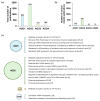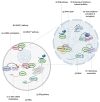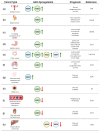Argonaute Proteins Take Center Stage in Cancers
- PMID: 33668654
- PMCID: PMC7918559
- DOI: 10.3390/cancers13040788
Argonaute Proteins Take Center Stage in Cancers
Abstract
Argonaute proteins (AGOs) play crucial roles in RNA-induced silencing complex (RISC) formation and activity. AGOs loaded with small RNA molecules (miRNA or siRNA) either catalyze endoribonucleolytic cleavage of target RNAs or recruit factors responsible for translational silencing and target destabilization. miRNAs are well characterized and broadly studied in tumorigenesis; nevertheless, the functions of the AGOs in cancers have lagged behind. Here, we discuss the current state of knowledge on the role of AGOs in tumorigenesis, highlighting canonical and non-canonical functions of AGOs in cancer cells, as well as the biomarker potential of AGO expression in different of tumor types. Furthermore, we point to the possible application of the AGOs in development of novel therapeutic approaches.
Keywords: Argonaute; biomarker; cancer; miRNA; therapeutics; tumorigenesis.
Conflict of interest statement
The authors declare no conflict of interest.
Figures



Similar articles
-
Diversity, expression and mRNA targeting abilities of Argonaute-targeting miRNAs among selected vascular plants.BMC Genomics. 2014 Dec 2;15(1):1049. doi: 10.1186/1471-2164-15-1049. BMC Genomics. 2014. PMID: 25443390 Free PMC article.
-
Comprehensive Evolutionary Analysis of the Major RNA-Induced Silencing Complex Members.Sci Rep. 2018 Sep 21;8(1):14189. doi: 10.1038/s41598-018-32635-4. Sci Rep. 2018. PMID: 30242207 Free PMC article.
-
Are Argonaute-Associated Tiny RNAs Junk, Inferior miRNAs, or a New Type of Functional RNAs?Front Mol Biosci. 2021 Dec 3;8:795356. doi: 10.3389/fmolb.2021.795356. eCollection 2021. Front Mol Biosci. 2021. PMID: 34926585 Free PMC article. Review.
-
RISC-interacting clearing 3'- 5' exoribonucleases (RICEs) degrade uridylated cleavage fragments to maintain functional RISC in Arabidopsis thaliana.Elife. 2017 May 2;6:e24466. doi: 10.7554/eLife.24466. Elife. 2017. PMID: 28463111 Free PMC article.
-
Plant ARGONAUTEs: Features, Functions, and Unknowns.Methods Mol Biol. 2017;1640:1-21. doi: 10.1007/978-1-4939-7165-7_1. Methods Mol Biol. 2017. PMID: 28608331 Review.
Cited by
-
Inhibitory Effects of Ursolic Acid on the Stemness and Progression of Human Breast Cancer Cells by Modulating Argonaute-2.Int J Mol Sci. 2022 Dec 26;24(1):366. doi: 10.3390/ijms24010366. Int J Mol Sci. 2022. PMID: 36613808 Free PMC article.
-
Tracking miR-17-5p Levels following Expression of Seven Reported Target mRNAs.Cancers (Basel). 2022 May 24;14(11):2585. doi: 10.3390/cancers14112585. Cancers (Basel). 2022. PMID: 35681567 Free PMC article.
-
Association of polymorphic variants in GEMIN genes with the risk of depression in a Polish population.PeerJ. 2022 Nov 15;10:e14317. doi: 10.7717/peerj.14317. eCollection 2022. PeerJ. 2022. PMID: 36405016 Free PMC article.
-
The Role of Nucleases Cleaving TLR3, TLR7/8 and TLR9 Ligands, Dicer RNase and miRNA/piRNA Proteins in Functional Adaptation to the Immune Escape and Xenophagy of Prostate Cancer Tissue.Int J Mol Sci. 2022 Dec 28;24(1):509. doi: 10.3390/ijms24010509. Int J Mol Sci. 2022. PMID: 36613950 Free PMC article.
-
Circular RNAs are Potential Prognostic Markers of Head and Neck Squamous Cell Carcinoma: Findings of a Meta-Analysis Study.Front Oncol. 2022 Feb 28;12:782439. doi: 10.3389/fonc.2022.782439. eCollection 2022. Front Oncol. 2022. PMID: 35296016 Free PMC article.
References
Publication types
Grants and funding
LinkOut - more resources
Full Text Sources
Other Literature Sources

